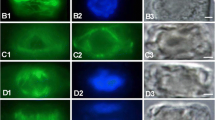Summary
Thick sections of fixed, embedded stomatal cells ofPhleum pratense were examined using high voltage electron microscopy and stereological procedures. The cortex of guard cells and subsidiary cells throughout differentiation contains numerous microtubules adjacent to the plasmalemma. Although microtubules are usually aligned in one net direction, individual microtubules may diverge from this orientation in various ways, producing anastomosing or crossed arrays. Also present in the cortex of both guard and subsidiary cells are collections of membranous elements and amorphous material upon which microtubules seem to focus, terminate or overlap. Such structures may constitute microtubule nucleation centers. The significance of these observations is discussed in terms of the control of microtubule development, wall microfibril deposition and cell morphogenesis.
Similar content being viewed by others
References
Byers, B., Shriver, K., Goetsch, L., 1978: The role of spindle pole bodies and modified microtubule ends in the initiation of microtubule assembly inSaccharomyces cerevisiae. J. Cell Sci.30, 331–352.
Dentler, W. L., Pratt, M. M., Stephens, R. E., 1980: Microtubule-membrane interactions in cilia. II. Photochemical cross-linking of bridge structures and the identification of a membrane-associated dynein-like ATPase. J. Cell Biol.84, 381–403.
Doohan, M. E., Palevitz, B. A., 1980: Microtubules and coated vesicles in guard-cell protoplasts ofAllium cepa L. Planta149, 389–401.
Dustin, P., 1978: Microtubules, 452 pp. Berlin-Heidelberg-New York: Springer.
Galatis, B., 1980: Microtubules and guard cell morphogenesis inZea mays. J. Cell Sci.45, 211–244.
Green, P. B., 1980: Organogenesis: a biophysical view. Ann. Rev. Plant Physiol.31, 51–82.
Gunning, B. E. S., Hardham, A. R., Hughes, J. E., 1978: Evidence for initiation of microtubules in discrete regions of the cell cortex inAzolla root tip cells, and an hypothesis on the development of cortical arrays of microtubules. Planta143, 161–167.
Hardham, A. R., Gunning, B. E. S., 1978: Structure of cortical microtubule arrays in plant cells. J. Cell Biol.77, 14–34.
— —, 1979: Interpolation of microtubules into cortical arrays during cell elongation and differentiation in roots ofAzolla pinnata. J. Cell Sci.37, 411–442.
Heath, I. B., 1974: Unified hypothesis for the role of membrane-bound enzyme complexes and microtubules in plant cell wall synthesis. J. theor. Biol.48, 445–449.
Hepler, P. K., Palevitz, B. A., 1974: Microtubules and microfilaments. Ann. Rev. Plant Physiol.25, 309–362.
Hogetsu, T., Shibaoka, H., 1978: The change in pattern of microfibril arrangement on the inner surface of the cell wall ofClosterium. Planta140, 7–14.
Hyams, J. S., Borisy, G. G., 1978: Nucleation of microtubulesin vitro by isolated spindle pole bodies of the yeastSaccharomyces cerevisiae. J. Cell Biol.78, 401–414.
Lloyd, C. W., Slabas, A. R., Powell, A. J., Lowe, S. B., 1980: Microtubules, protoplasts and cell shape. Planta147, 500–506.
Mishkind, M.,Palevitz, B. A.,Raikhel, N., 1981: Cell wall architecture: normal development and environmental modification of guard cells of theCyperaceae and related species. Plant, Cell and Environment, in press.
Nicolson, G. L., 1976: Cytoplasmic influence over cell surface components. Biophys. biochim. Acta457, 57–108.
Palevitz, B. A., 1978: Cortical microtubules in plant cells: a high voltage electron microscope study. J. Cell Biol.79, 278 a.
Palevitz, B. A., 1981: The structure and development of stomatal cells. In: Stomatal Physiology (Jarvis, P. G., Mansfield, T. A., eds.). Cambridge: Cambridge University Press (in press).
—,Hepler, P. K., 1974: The control of the plane of division during stomatal differentiation inAllium. I. Spindle reorientation. Chromosoma46, 297–326.
— —, 1976: Cellulose microfibril orientation and cell shaping in developing guard cells ofAllium-role of microtubules and ion accumulation. Planta132, 71–93.
Reynolds, E. S., 1963: The use of lead citrate at high pH as an electron opaque stain in electron microscopy. J. Cell Biol.17, 108–212.
Spurr, A. R., 1969: A low-viscosity epoxy resin embedding medium for electron microscopy. J. Ultrastruct. Res.26, 31–43.
Stearns, M. E., Brown, D. L., 1979: Purification of cytoplasmic tubulin and microtubule organizing center proteins functioning in microtubule initiation from the alga,Polytomella. Proc. nat. Acad. Sci.76, 5745–5749.
Stephens, R. E., Edds, K. T., 1976: Microtubules: structure, chemistry, and function. Physiol. Rev.56, 709–777.
Author information
Authors and Affiliations
Rights and permissions
About this article
Cite this article
Palevitz, B.A. Microtubules and possible microtubule nucleation centers in the cortex of stomatal cells as visualized by high voltage electron microscopy. Protoplasma 107, 115–125 (1981). https://doi.org/10.1007/BF01275612
Received:
Accepted:
Issue Date:
DOI: https://doi.org/10.1007/BF01275612




